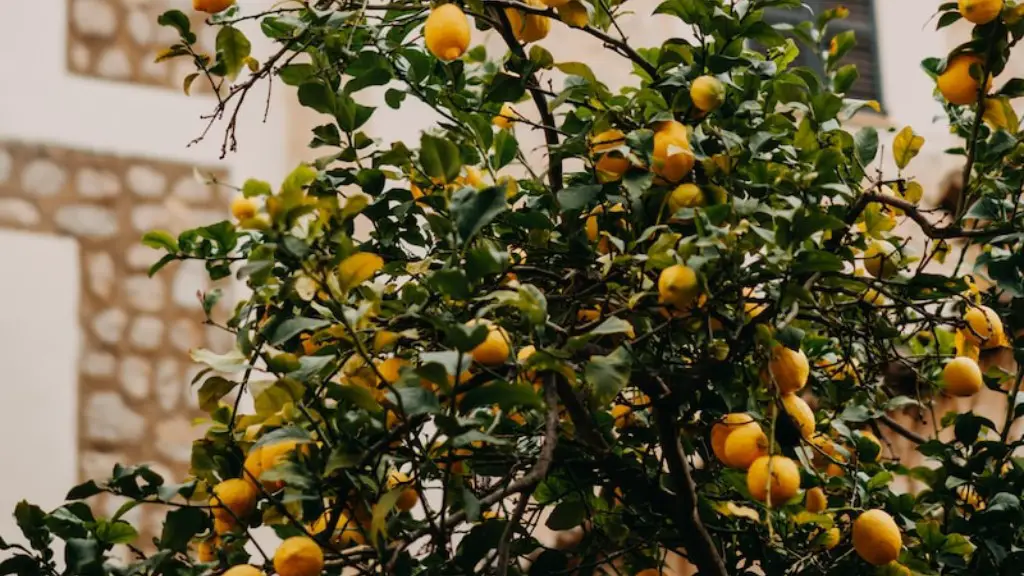The question of whether you can keep a lemon tree in a pot as opposed to in the ground has become increasingly popular in recent years. To answer this question, it’s important to understand whether a lemon tree’s root system will be able to effectively absorb the nutrient resources the tree needs to survive in a pot instead of in the ground. With proper care and the right soil and pot, these trees definitely can thrive in potted environments.
The type of pot is an important factor when considering whether a lemon tree can be kept in a pot. A pot that’s large enough to accommodate the Lemon tree’s root ball is ideal. Clay, terracotta, or plastic pots that have plenty of drainage holes are best. Be sure to pick a pot that allows for adequate drainage, as large pots can retain too much water and cause root rot or other issues.
The type of soil is also important. You have a few options when it comes to soil for potted lemon trees. A premixed potting soil can be used for these trees, although it’s best to look for a soil that has been formulated for citrus plants specifically. If you make your own soil, you need to ensure that it’s formulated for use in a pot and not in the ground.
If you’re keeping a lemon tree in a pot, then you’ll want to pay close attention to its water needs. The key is to provide enough water but not too much. Watering frequency will depend on how hot and dry the climate is, how much sunlight it gets, and the size of the pot. If the soil is dry to the touch, then it’s time to water, otherwise it’s best to wait a few days before checking again.
Potted Lemon Trees need to be fertilized regularly. A balanced fertilizer like a 10-10-10 should be used. The fertilizers should be applied at least four times a year, being sure to follow the directions on the label.
Caring for potted lemon trees also means providing them with adequate sunlight. Lemon trees need to receive at least six hours of sunlight a day. The best place to place the trees is in a sunny spot outdoors or near a bright window in the house.
Finally, it’s important to regularly repot your lemon tree in order to provide the plant with new soil and the larger pot that it needs as it grows. Be sure to wait until the tree has grown out of the pot before repotting.
Fertilizers
Fertilizers are essential for potted lemon trees, as they help to provide the necessary nutrients for growth. Lemon trees can be fertilized with a balanced fertilizer such as a 10-10-10 fertilizer. Fertilizers are typically applied four times a year and it is important to follow the directions on the label. Additionally, if the lemon tree is growing in a pot indoors, a slow-release fertilizer can be used to help ensure that the tree receives the nutrients it needs for a long time.
Watering
Potted lemon trees need to be watered regularly in order to stay healthy. Lemon trees should be watered when the soil is dry to the touch. The frequency of watering will depend on the size of the pot and the amount of sun and heat the plant is exposed to. Too much water can cause root rot, so it is important to not over water the plant.
Pests and Disease
Pests and disease should be monitored closely when growing a potted lemon tree. The main pests that can affect a lemon tree are aphids, mealybugs, and scale. If a pest problem is identified, it is important to take care of it early on to reduce the damage to the tree. Disease prevention includes regular dusting of the leaves and avoiding over-watering.
Pruning
Pruning a lemon tree in a pot is important to keep the tree healthy and promote new growth. Pruning should be done when the tree is actively growing, which is usually during the spring or fall months. In order to prune effectively, it is important to identify the dead or dying branches and then remove them with a pair of pruners or loppers.
Winter Protection
Potted lemon trees that are kept outdoors in areas with cold winters may need additional protection from the cold temperatures. Lemon trees that are placed in pots need to be periodically moved into a sheltered area during periods of cold temperatures or when frost is anticipated. Additionally, it is important to mulch the pot with hay or straw bales to insulate the roots.



